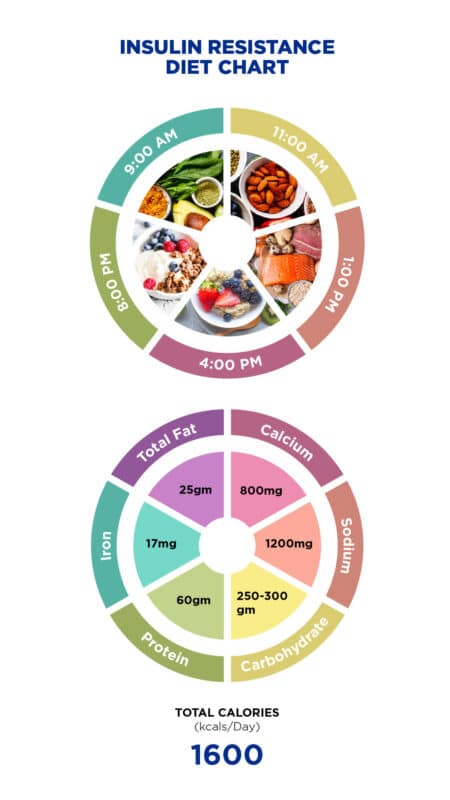Insulin Resistance Diet, Menu and Best Tips
Insulin Resistance – Tips from Our Nutritionists
What can I eat on an insulin resistance diet? According to our nutritionist Carlos Sanchez, with proper dietary management and regular check-ups, insulin resistance can be controlled, and in some cases even reversed. Read on and learn how.
What is Insulin Resistance?
Our CMQ Premiere Hospital nutritionist, Carlos Sanchez, explains that insulin is a hormone that is produced in the pancreas. The main function of this hormone is to regulate the glucose, or sugar levels, in the blood. When liver cells, as well as fat and muscles, are not able to use insulin, they can’t absorb the glucose in the blood. This is when insulin resistance can happen. Unfortunately, when cells cannot absorb glucose, sugar levels build up in the blood. Therefore, if sugar levels are higher than usual, but not high enough to be considered diabetes, it is called insulin resistance.
Insulin resistance is a condition where the body is not able to properly control blood sugar levels. If it is not detected and controlled early , it can lead to prediabetes.

The good news? With proper nutrition, you can lower your blood sugar levels, control insulin resistance, and prevent getting diabetes. However, there is no general diet to treat insulin resistance. Therefore, ideally, each individual should see his or her specialist for a personalized approach.
Who is Most Likely to Develop Insulin Resistance?
According to the National Institute of Diabetes and Digestive and Kidney Diseases (NIDDK), people with genetic or sedentary lifestyle risk factors are more likely to develop insulin resistance.
Some of these risk factors are:
- Being overweight or obese
- Having a family history of diabetes
- Physical inactivity
- Excessive consumption of products that are high in sugars and carbohydrates
- High blood pressure and/or high cholesterol
Unfortunately, there are risk factors, such as family history, that a person cannot change. However, individuals can change lifestyle risk factors, such as diet, physical activity and weight. In fact, making some lifestyle changes can decrease the likelihood of developing insulin resistance or prediabetes.
What to Eat On an Insulin Resistance Diet?
An insulin resistance diet lies in eating a healthy and balanced diet. According to nutrition specialist Carlos Sanchez, there is no miracle diet. Besides, each one of us has different needs. Therefore, it is recommended not to self-diagnose, and to consult with a specialist instead. Our nutritionist in Puerto Vallarta gives us a sample insulin resistance diet:

Sample Menu for Insulin Resistance
| Breakfast |
|
| Snack |
|
| Lunch |
|
| Snack |
|
| Dinner |
|
What Foods Should I Avoid on an Insulin Resistance Diet?
Similarly, our featured Hospital CMQ nutritionist shares with us a list of foods that should not be eaten while on an insulin resistance diet:
- Avoid consuming sweet products: avoid desserts, jams, jellies, caramel, sugars, honey, fruit juices, flavored waters, and soft drinks. These foods are rich in simple carbohydrates and can quickly raise blood glucose levels.
- Fruits by themselves: Eating fruits by themselves can raise blood sugar, so pair them with other fat-containing foods, like nuts or almonds, or choose fruits that you can eat along with their peel.
- Excess sodium: Limit salt consumption to 1 pinch of salt per meal.
- Sausages: Avoid consuming cold cuts, sausages, and cold meats (sausage, hams, chorizo, etc).
- Canned foods: Avoid eating canned and packaged foods, as they are high in sodium.
- Alcoholic drinks: Avoid consuming alcoholic beverages. Alcoholic beverages, such as mixed drinks and beer, contain a high percentage of carbohydrates. These carbohydrates can increase blood sugar levels.
In addition to the list above, our nutrition specialist explains that it is recommended to practice the following habits when following an insulin resistance diet:
- Consume about 2 liters of water per day, gradually throughout the day.
- Try to chew your food properly and take your time with each meal.
- Regulate your sleeping hours and sleep 6 to 8 hours every night.
- Perform at least 30 minutes of cardiovascular exercise per day. Jogging, walking, swimming or cycling are considered cardiovascular exercises. Cardiovascular exercise is also known as aerobic exercise.
Do You Have Insulin Resistance? Schedule your Appointment with our Nutritionists!
Insulin resistance is a chronic disease, just like obesity. Therefore, there is a high chance that insulin resistance will evolve into Diabetes Mellitus type 2 or even metabolic syndrome. For this reason, it is important that you see your nutrition specialist for a body composition assessment, as well as glucose and insulin studies. Subsequently, if necessary, your nutritionist can provide you with the best diet for insulin resistance.
Frequently Asked Questions about Insulin Resistance Diets
A person with insulin resistance will experience symptoms like:
- Fatigue: feeling of frequent and excessive tiredness.
- Cephalalgia: headaches may be frequent.
- Drowsiness: a feeling of sleepiness, especially after consuming food, which is worse after eating foods that are high in carbohydrates.
- Acanthosis nigricans: darker pigmentation with some dryness. These are usually dark spots that appear on the neck, armpits and groin.
Several methods can be used to diagnose insulin resistance:
- Capillary glucose test or enzyme test strip (Dextrostix): this is the most common test to diagnose possible insulin resistance.
- Blood glucose test: used to see if blood glucose levels are within normal limits.
- Fasting as a means of measurement: used to detect current insulin levels in a person’s blood, and possible insulin resistance.
- Glycosylated hemoglobin: a test that is useful for measuring a person’s average blood sugar (glucose) level over the past three months.
- Glucose tolerance test: an oral and blood test that measures the body’s response and tolerance to glucose.
- Physical examination: evaluation of your weight, height, body mass index, abdominal circumference, to determine if you are overweight or obese.
It is necessary to visit a nutrition specialist for a body composition assessment. The diagnosis should be confirmed through biochemical and laboratory studies. Likewise, the nutritionist will create a food plan according to the needs and objectives of each person.
It is recommended to avoid foods that are high in sugar. In addition, it is advisable to avoid foods that are high in fat such as:
- Refined sugars
- Jams, desserts or sweets
- Syrups and honey
- Refined flours
- Sugar/box cereals
- Fruit drinks, soft drinks, and alcohol





